Global Health Nursing in the 21st Century: Challenges and Strategies
VerifiedAdded on 2021/04/21
|17
|3354
|19
Essay
AI Summary
This essay, titled "Global health nursing challenges of the 21st century," addresses the significant issues facing the global nursing workforce. It identifies key challenges such as the aging population, the increasing prevalence of chronic diseases, climate change, and urbanization, all of which demand enhanced skills and competencies from nurses. The essay argues that nurses must adapt their skills and knowledge to effectively address these challenges, particularly those related to the aging population and non-communicable diseases. It further explores the impact of climate change and other environmental factors on healthcare, emphasizing the need for nurses to play a crucial role in disaster preparedness and sustainable development. The essay concludes by highlighting the importance of continuous professional development and the integration of sustainability into nursing education to equip the nursing workforce for future challenges. The essay is well-supported by research and provides a detailed analysis of the challenges and potential solutions, emphasizing the need for nurses to upgrade their skills to meet the evolving demands of the healthcare landscape.
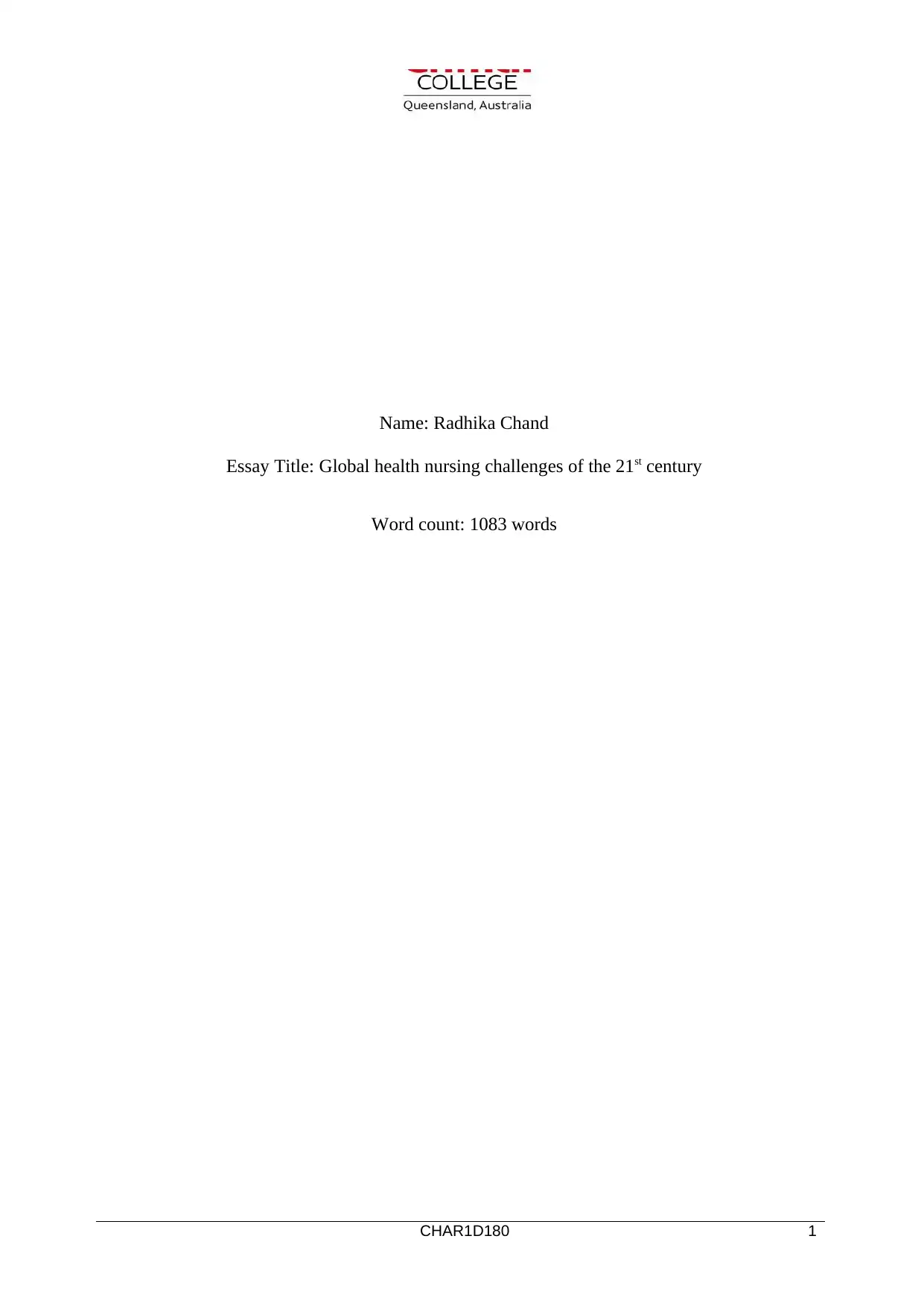
CHAR1D180
1
1
Name: Radhika Chand
Essay Title: Global health nursing challenges of the 21st century
Word count: 1083 words
1
1
Name: Radhika Chand
Essay Title: Global health nursing challenges of the 21st century
Word count: 1083 words
Paraphrase This Document
Need a fresh take? Get an instant paraphrase of this document with our AI Paraphraser
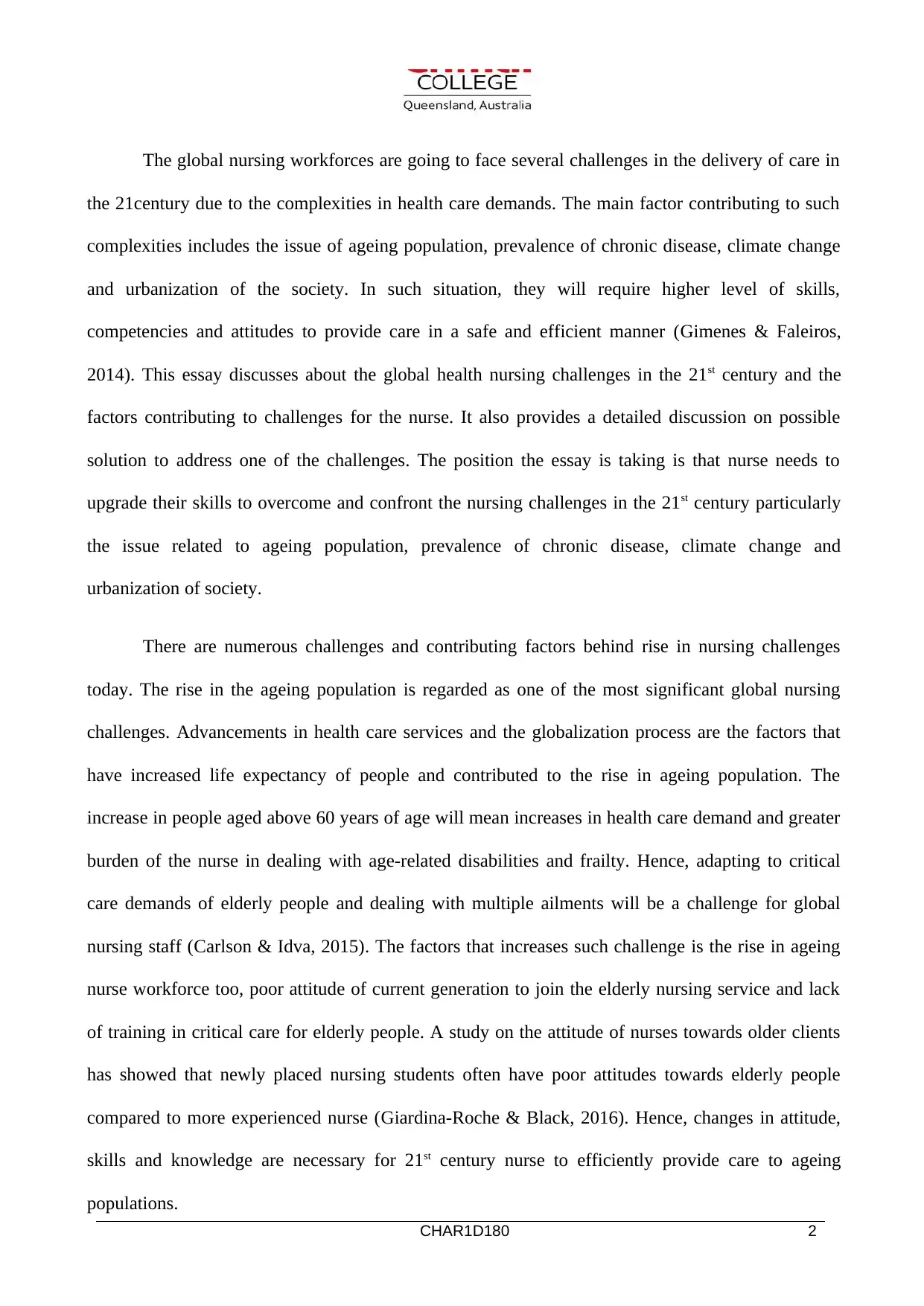
CHAR1D180
1
2
The global nursing workforces are going to face several challenges in the delivery of care in
the 21century due to the complexities in health care demands. The main factor contributing to such
complexities includes the issue of ageing population, prevalence of chronic disease, climate change
and urbanization of the society. In such situation, they will require higher level of skills,
competencies and attitudes to provide care in a safe and efficient manner (Gimenes & Faleiros,
2014). This essay discusses about the global health nursing challenges in the 21st century and the
factors contributing to challenges for the nurse. It also provides a detailed discussion on possible
solution to address one of the challenges. The position the essay is taking is that nurse needs to
upgrade their skills to overcome and confront the nursing challenges in the 21st century particularly
the issue related to ageing population, prevalence of chronic disease, climate change and
urbanization of society.
There are numerous challenges and contributing factors behind rise in nursing challenges
today. The rise in the ageing population is regarded as one of the most significant global nursing
challenges. Advancements in health care services and the globalization process are the factors that
have increased life expectancy of people and contributed to the rise in ageing population. The
increase in people aged above 60 years of age will mean increases in health care demand and greater
burden of the nurse in dealing with age-related disabilities and frailty. Hence, adapting to critical
care demands of elderly people and dealing with multiple ailments will be a challenge for global
nursing staff (Carlson & Idva, 2015). The factors that increases such challenge is the rise in ageing
nurse workforce too, poor attitude of current generation to join the elderly nursing service and lack
of training in critical care for elderly people. A study on the attitude of nurses towards older clients
has showed that newly placed nursing students often have poor attitudes towards elderly people
compared to more experienced nurse (Giardina-Roche & Black, 2016). Hence, changes in attitude,
skills and knowledge are necessary for 21st century nurse to efficiently provide care to ageing
populations.
1
2
The global nursing workforces are going to face several challenges in the delivery of care in
the 21century due to the complexities in health care demands. The main factor contributing to such
complexities includes the issue of ageing population, prevalence of chronic disease, climate change
and urbanization of the society. In such situation, they will require higher level of skills,
competencies and attitudes to provide care in a safe and efficient manner (Gimenes & Faleiros,
2014). This essay discusses about the global health nursing challenges in the 21st century and the
factors contributing to challenges for the nurse. It also provides a detailed discussion on possible
solution to address one of the challenges. The position the essay is taking is that nurse needs to
upgrade their skills to overcome and confront the nursing challenges in the 21st century particularly
the issue related to ageing population, prevalence of chronic disease, climate change and
urbanization of society.
There are numerous challenges and contributing factors behind rise in nursing challenges
today. The rise in the ageing population is regarded as one of the most significant global nursing
challenges. Advancements in health care services and the globalization process are the factors that
have increased life expectancy of people and contributed to the rise in ageing population. The
increase in people aged above 60 years of age will mean increases in health care demand and greater
burden of the nurse in dealing with age-related disabilities and frailty. Hence, adapting to critical
care demands of elderly people and dealing with multiple ailments will be a challenge for global
nursing staff (Carlson & Idva, 2015). The factors that increases such challenge is the rise in ageing
nurse workforce too, poor attitude of current generation to join the elderly nursing service and lack
of training in critical care for elderly people. A study on the attitude of nurses towards older clients
has showed that newly placed nursing students often have poor attitudes towards elderly people
compared to more experienced nurse (Giardina-Roche & Black, 2016). Hence, changes in attitude,
skills and knowledge are necessary for 21st century nurse to efficiently provide care to ageing
populations.
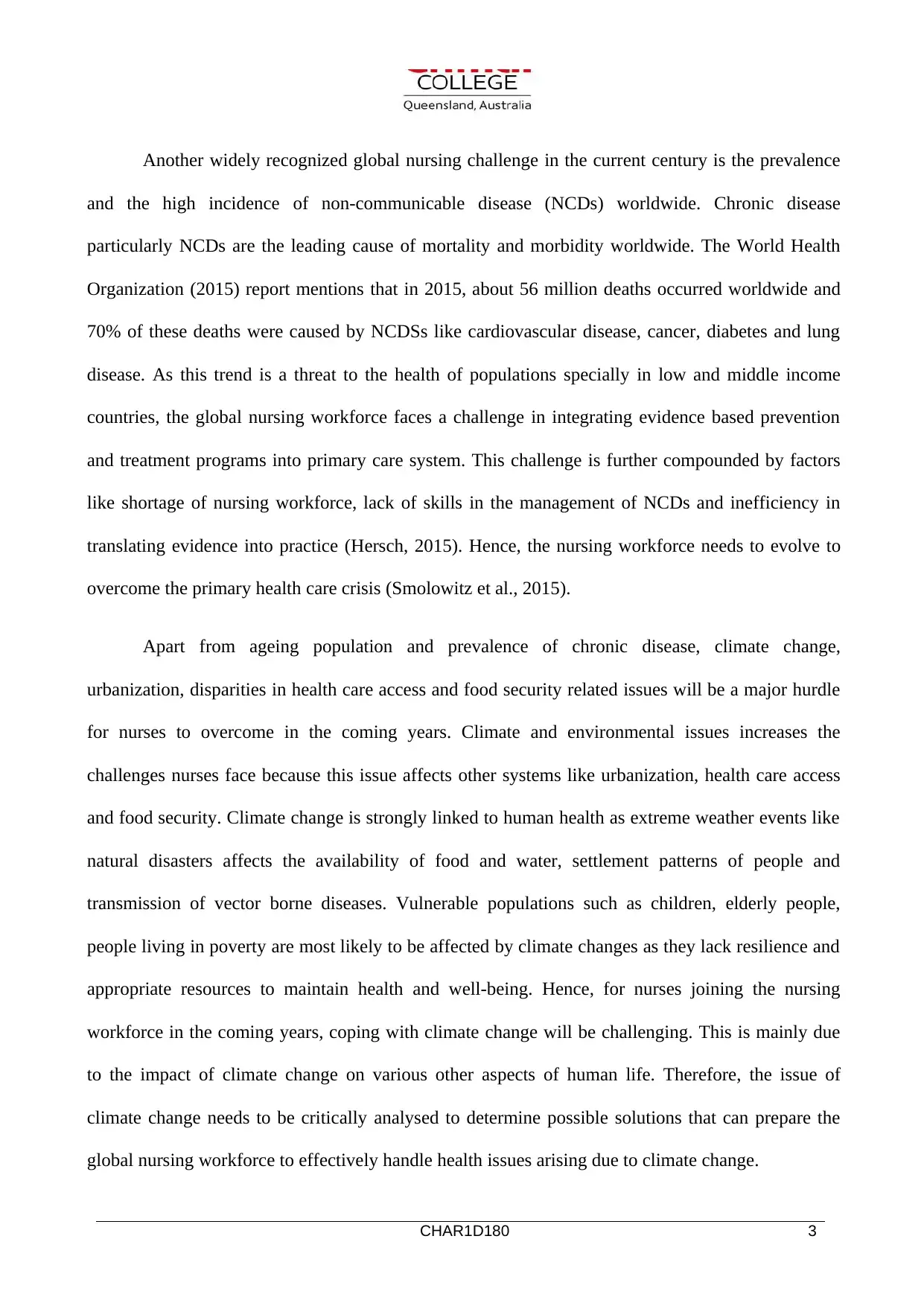
CHAR1D180
1
3
Another widely recognized global nursing challenge in the current century is the prevalence
and the high incidence of non-communicable disease (NCDs) worldwide. Chronic disease
particularly NCDs are the leading cause of mortality and morbidity worldwide. The World Health
Organization (2015) report mentions that in 2015, about 56 million deaths occurred worldwide and
70% of these deaths were caused by NCDSs like cardiovascular disease, cancer, diabetes and lung
disease. As this trend is a threat to the health of populations specially in low and middle income
countries, the global nursing workforce faces a challenge in integrating evidence based prevention
and treatment programs into primary care system. This challenge is further compounded by factors
like shortage of nursing workforce, lack of skills in the management of NCDs and inefficiency in
translating evidence into practice (Hersch, 2015). Hence, the nursing workforce needs to evolve to
overcome the primary health care crisis (Smolowitz et al., 2015).
Apart from ageing population and prevalence of chronic disease, climate change,
urbanization, disparities in health care access and food security related issues will be a major hurdle
for nurses to overcome in the coming years. Climate and environmental issues increases the
challenges nurses face because this issue affects other systems like urbanization, health care access
and food security. Climate change is strongly linked to human health as extreme weather events like
natural disasters affects the availability of food and water, settlement patterns of people and
transmission of vector borne diseases. Vulnerable populations such as children, elderly people,
people living in poverty are most likely to be affected by climate changes as they lack resilience and
appropriate resources to maintain health and well-being. Hence, for nurses joining the nursing
workforce in the coming years, coping with climate change will be challenging. This is mainly due
to the impact of climate change on various other aspects of human life. Therefore, the issue of
climate change needs to be critically analysed to determine possible solutions that can prepare the
global nursing workforce to effectively handle health issues arising due to climate change.
1
3
Another widely recognized global nursing challenge in the current century is the prevalence
and the high incidence of non-communicable disease (NCDs) worldwide. Chronic disease
particularly NCDs are the leading cause of mortality and morbidity worldwide. The World Health
Organization (2015) report mentions that in 2015, about 56 million deaths occurred worldwide and
70% of these deaths were caused by NCDSs like cardiovascular disease, cancer, diabetes and lung
disease. As this trend is a threat to the health of populations specially in low and middle income
countries, the global nursing workforce faces a challenge in integrating evidence based prevention
and treatment programs into primary care system. This challenge is further compounded by factors
like shortage of nursing workforce, lack of skills in the management of NCDs and inefficiency in
translating evidence into practice (Hersch, 2015). Hence, the nursing workforce needs to evolve to
overcome the primary health care crisis (Smolowitz et al., 2015).
Apart from ageing population and prevalence of chronic disease, climate change,
urbanization, disparities in health care access and food security related issues will be a major hurdle
for nurses to overcome in the coming years. Climate and environmental issues increases the
challenges nurses face because this issue affects other systems like urbanization, health care access
and food security. Climate change is strongly linked to human health as extreme weather events like
natural disasters affects the availability of food and water, settlement patterns of people and
transmission of vector borne diseases. Vulnerable populations such as children, elderly people,
people living in poverty are most likely to be affected by climate changes as they lack resilience and
appropriate resources to maintain health and well-being. Hence, for nurses joining the nursing
workforce in the coming years, coping with climate change will be challenging. This is mainly due
to the impact of climate change on various other aspects of human life. Therefore, the issue of
climate change needs to be critically analysed to determine possible solutions that can prepare the
global nursing workforce to effectively handle health issues arising due to climate change.
⊘ This is a preview!⊘
Do you want full access?
Subscribe today to unlock all pages.

Trusted by 1+ million students worldwide
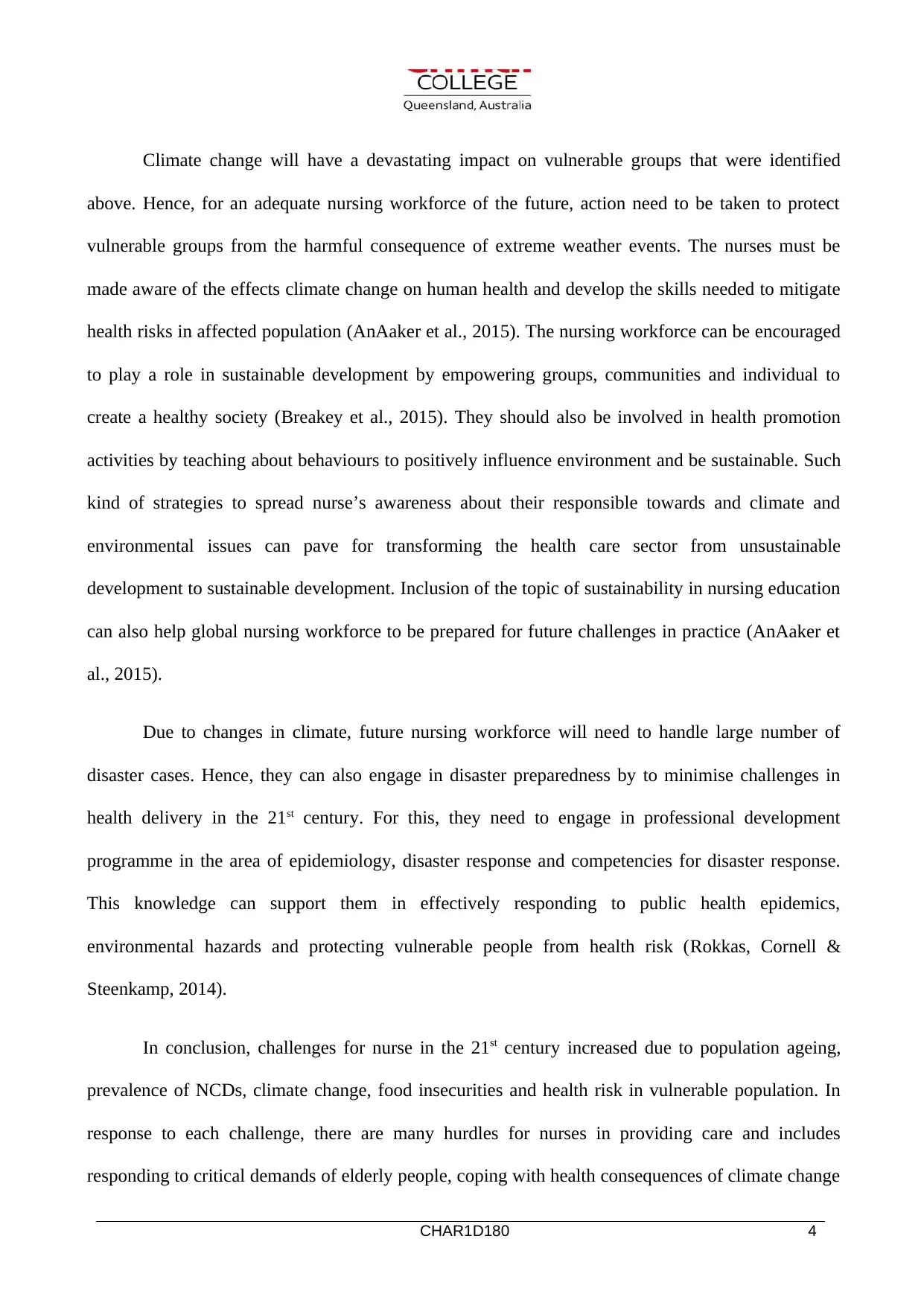
CHAR1D180
1
4
Climate change will have a devastating impact on vulnerable groups that were identified
above. Hence, for an adequate nursing workforce of the future, action need to be taken to protect
vulnerable groups from the harmful consequence of extreme weather events. The nurses must be
made aware of the effects climate change on human health and develop the skills needed to mitigate
health risks in affected population (AnAaker et al., 2015). The nursing workforce can be encouraged
to play a role in sustainable development by empowering groups, communities and individual to
create a healthy society (Breakey et al., 2015). They should also be involved in health promotion
activities by teaching about behaviours to positively influence environment and be sustainable. Such
kind of strategies to spread nurse’s awareness about their responsible towards and climate and
environmental issues can pave for transforming the health care sector from unsustainable
development to sustainable development. Inclusion of the topic of sustainability in nursing education
can also help global nursing workforce to be prepared for future challenges in practice (AnAaker et
al., 2015).
Due to changes in climate, future nursing workforce will need to handle large number of
disaster cases. Hence, they can also engage in disaster preparedness by to minimise challenges in
health delivery in the 21st century. For this, they need to engage in professional development
programme in the area of epidemiology, disaster response and competencies for disaster response.
This knowledge can support them in effectively responding to public health epidemics,
environmental hazards and protecting vulnerable people from health risk (Rokkas, Cornell &
Steenkamp, 2014).
In conclusion, challenges for nurse in the 21st century increased due to population ageing,
prevalence of NCDs, climate change, food insecurities and health risk in vulnerable population. In
response to each challenge, there are many hurdles for nurses in providing care and includes
responding to critical demands of elderly people, coping with health consequences of climate change
1
4
Climate change will have a devastating impact on vulnerable groups that were identified
above. Hence, for an adequate nursing workforce of the future, action need to be taken to protect
vulnerable groups from the harmful consequence of extreme weather events. The nurses must be
made aware of the effects climate change on human health and develop the skills needed to mitigate
health risks in affected population (AnAaker et al., 2015). The nursing workforce can be encouraged
to play a role in sustainable development by empowering groups, communities and individual to
create a healthy society (Breakey et al., 2015). They should also be involved in health promotion
activities by teaching about behaviours to positively influence environment and be sustainable. Such
kind of strategies to spread nurse’s awareness about their responsible towards and climate and
environmental issues can pave for transforming the health care sector from unsustainable
development to sustainable development. Inclusion of the topic of sustainability in nursing education
can also help global nursing workforce to be prepared for future challenges in practice (AnAaker et
al., 2015).
Due to changes in climate, future nursing workforce will need to handle large number of
disaster cases. Hence, they can also engage in disaster preparedness by to minimise challenges in
health delivery in the 21st century. For this, they need to engage in professional development
programme in the area of epidemiology, disaster response and competencies for disaster response.
This knowledge can support them in effectively responding to public health epidemics,
environmental hazards and protecting vulnerable people from health risk (Rokkas, Cornell &
Steenkamp, 2014).
In conclusion, challenges for nurse in the 21st century increased due to population ageing,
prevalence of NCDs, climate change, food insecurities and health risk in vulnerable population. In
response to each challenge, there are many hurdles for nurses in providing care and includes
responding to critical demands of elderly people, coping with health consequences of climate change
Paraphrase This Document
Need a fresh take? Get an instant paraphrase of this document with our AI Paraphraser
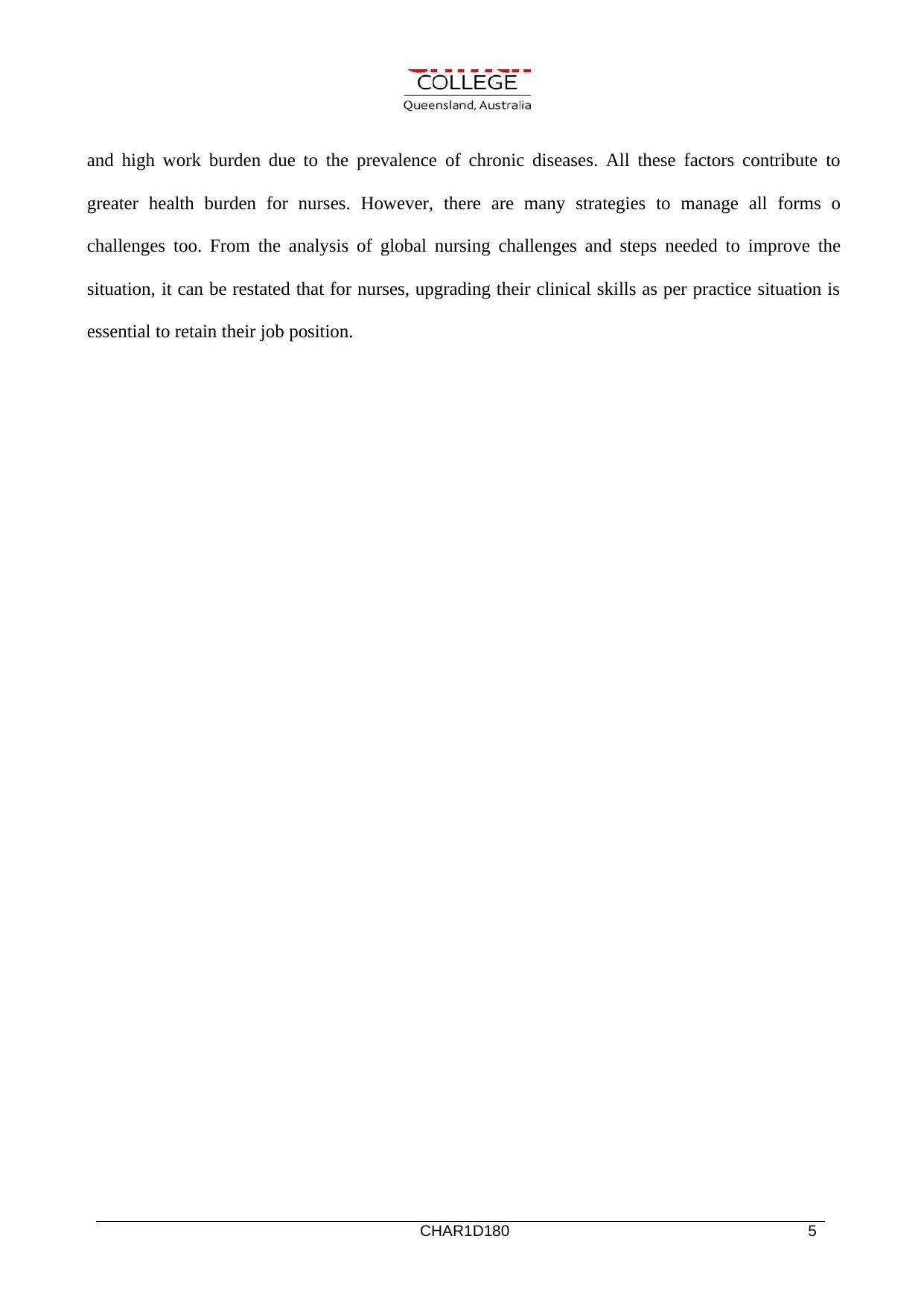
CHAR1D180
1
5
and high work burden due to the prevalence of chronic diseases. All these factors contribute to
greater health burden for nurses. However, there are many strategies to manage all forms o
challenges too. From the analysis of global nursing challenges and steps needed to improve the
situation, it can be restated that for nurses, upgrading their clinical skills as per practice situation is
essential to retain their job position.
1
5
and high work burden due to the prevalence of chronic diseases. All these factors contribute to
greater health burden for nurses. However, there are many strategies to manage all forms o
challenges too. From the analysis of global nursing challenges and steps needed to improve the
situation, it can be restated that for nurses, upgrading their clinical skills as per practice situation is
essential to retain their job position.
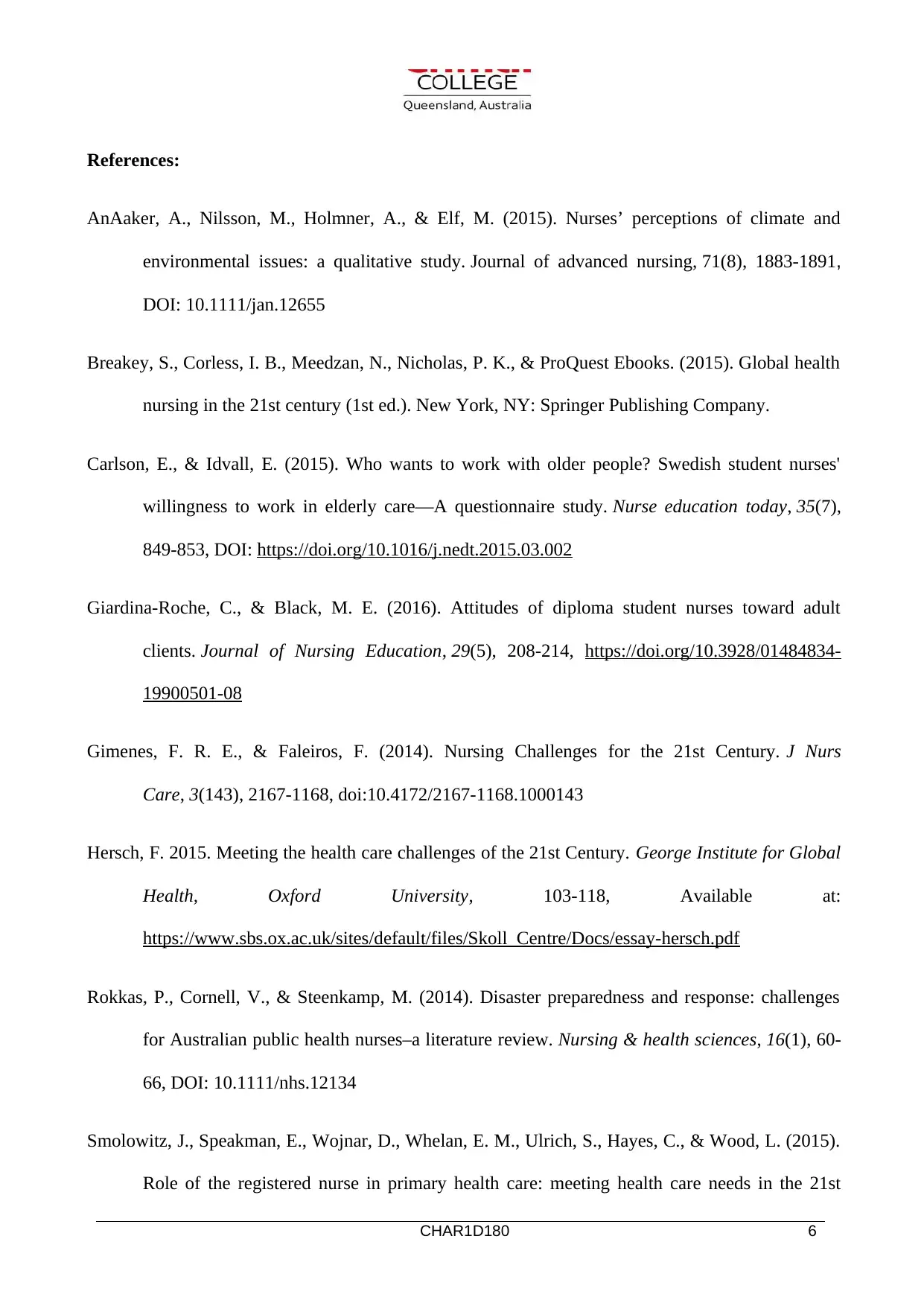
CHAR1D180
1
6
References:
AnAaker, A., Nilsson, M., Holmner, A., & Elf, M. (2015). Nurses’ perceptions of climate and
environmental issues: a qualitative study. Journal of advanced nursing, 71(8), 1883-1891,
DOI: 10.1111/jan.12655
Breakey, S., Corless, I. B., Meedzan, N., Nicholas, P. K., & ProQuest Ebooks. (2015). Global health
nursing in the 21st century (1st ed.). New York, NY: Springer Publishing Company.
Carlson, E., & Idvall, E. (2015). Who wants to work with older people? Swedish student nurses'
willingness to work in elderly care—A questionnaire study. Nurse education today, 35(7),
849-853, DOI: https://doi.org/10.1016/j.nedt.2015.03.002
Giardina-Roche, C., & Black, M. E. (2016). Attitudes of diploma student nurses toward adult
clients. Journal of Nursing Education, 29(5), 208-214, https://doi.org/10.3928/01484834-
19900501-08
Gimenes, F. R. E., & Faleiros, F. (2014). Nursing Challenges for the 21st Century. J Nurs
Care, 3(143), 2167-1168, doi:10.4172/2167-1168.1000143
Hersch, F. 2015. Meeting the health care challenges of the 21st Century. George Institute for Global
Health, Oxford University, 103-118, Available at:
https://www.sbs.ox.ac.uk/sites/default/files/Skoll_Centre/Docs/essay-hersch.pdf
Rokkas, P., Cornell, V., & Steenkamp, M. (2014). Disaster preparedness and response: challenges
for Australian public health nurses–a literature review. Nursing & health sciences, 16(1), 60-
66, DOI: 10.1111/nhs.12134
Smolowitz, J., Speakman, E., Wojnar, D., Whelan, E. M., Ulrich, S., Hayes, C., & Wood, L. (2015).
Role of the registered nurse in primary health care: meeting health care needs in the 21st
1
6
References:
AnAaker, A., Nilsson, M., Holmner, A., & Elf, M. (2015). Nurses’ perceptions of climate and
environmental issues: a qualitative study. Journal of advanced nursing, 71(8), 1883-1891,
DOI: 10.1111/jan.12655
Breakey, S., Corless, I. B., Meedzan, N., Nicholas, P. K., & ProQuest Ebooks. (2015). Global health
nursing in the 21st century (1st ed.). New York, NY: Springer Publishing Company.
Carlson, E., & Idvall, E. (2015). Who wants to work with older people? Swedish student nurses'
willingness to work in elderly care—A questionnaire study. Nurse education today, 35(7),
849-853, DOI: https://doi.org/10.1016/j.nedt.2015.03.002
Giardina-Roche, C., & Black, M. E. (2016). Attitudes of diploma student nurses toward adult
clients. Journal of Nursing Education, 29(5), 208-214, https://doi.org/10.3928/01484834-
19900501-08
Gimenes, F. R. E., & Faleiros, F. (2014). Nursing Challenges for the 21st Century. J Nurs
Care, 3(143), 2167-1168, doi:10.4172/2167-1168.1000143
Hersch, F. 2015. Meeting the health care challenges of the 21st Century. George Institute for Global
Health, Oxford University, 103-118, Available at:
https://www.sbs.ox.ac.uk/sites/default/files/Skoll_Centre/Docs/essay-hersch.pdf
Rokkas, P., Cornell, V., & Steenkamp, M. (2014). Disaster preparedness and response: challenges
for Australian public health nurses–a literature review. Nursing & health sciences, 16(1), 60-
66, DOI: 10.1111/nhs.12134
Smolowitz, J., Speakman, E., Wojnar, D., Whelan, E. M., Ulrich, S., Hayes, C., & Wood, L. (2015).
Role of the registered nurse in primary health care: meeting health care needs in the 21st
⊘ This is a preview!⊘
Do you want full access?
Subscribe today to unlock all pages.

Trusted by 1+ million students worldwide
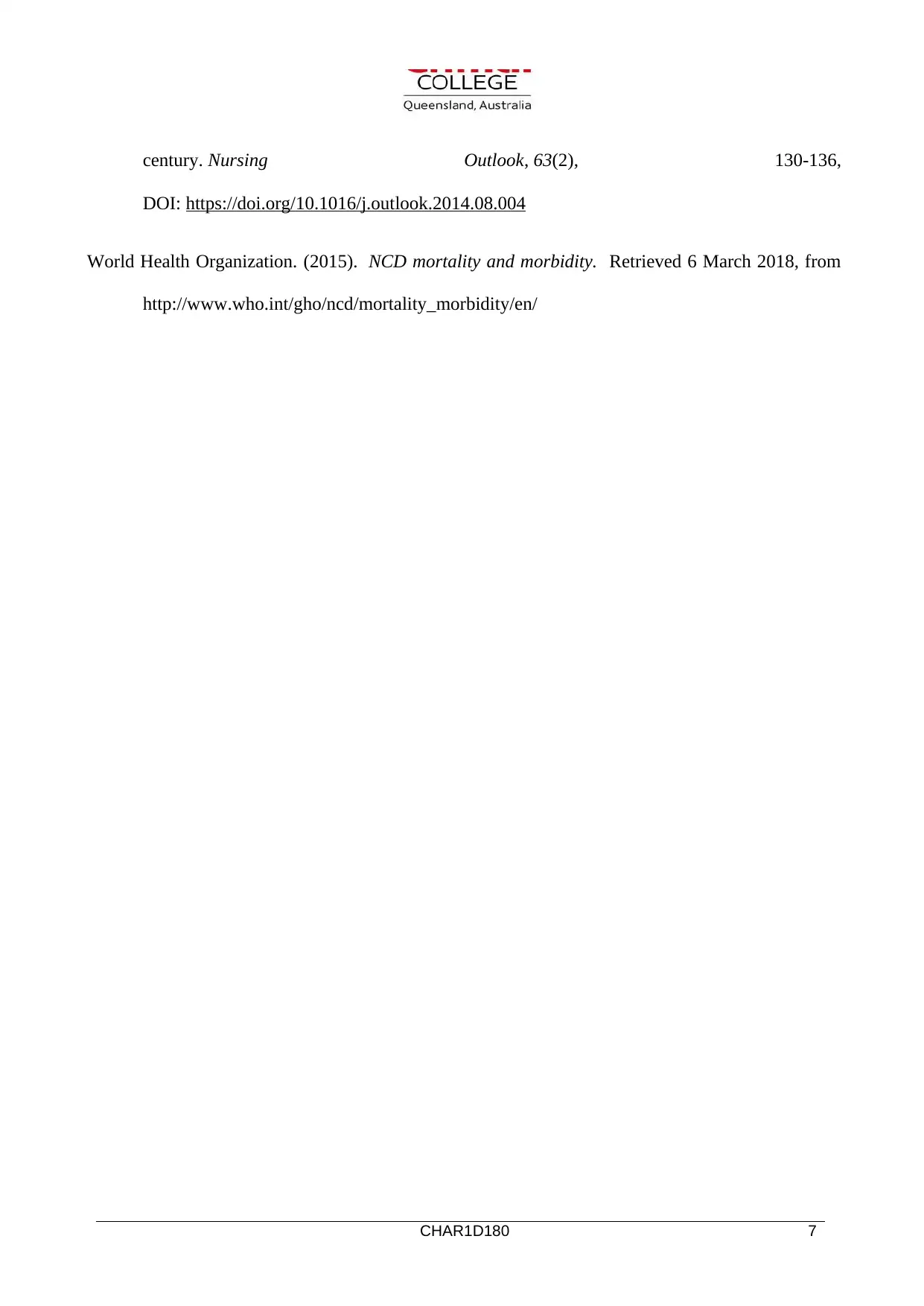
CHAR1D180
1
7
century. Nursing Outlook, 63(2), 130-136,
DOI: https://doi.org/10.1016/j.outlook.2014.08.004
World Health Organization. (2015). NCD mortality and morbidity. Retrieved 6 March 2018, from
http://www.who.int/gho/ncd/mortality_morbidity/en/
1
7
century. Nursing Outlook, 63(2), 130-136,
DOI: https://doi.org/10.1016/j.outlook.2014.08.004
World Health Organization. (2015). NCD mortality and morbidity. Retrieved 6 March 2018, from
http://www.who.int/gho/ncd/mortality_morbidity/en/
Paraphrase This Document
Need a fresh take? Get an instant paraphrase of this document with our AI Paraphraser
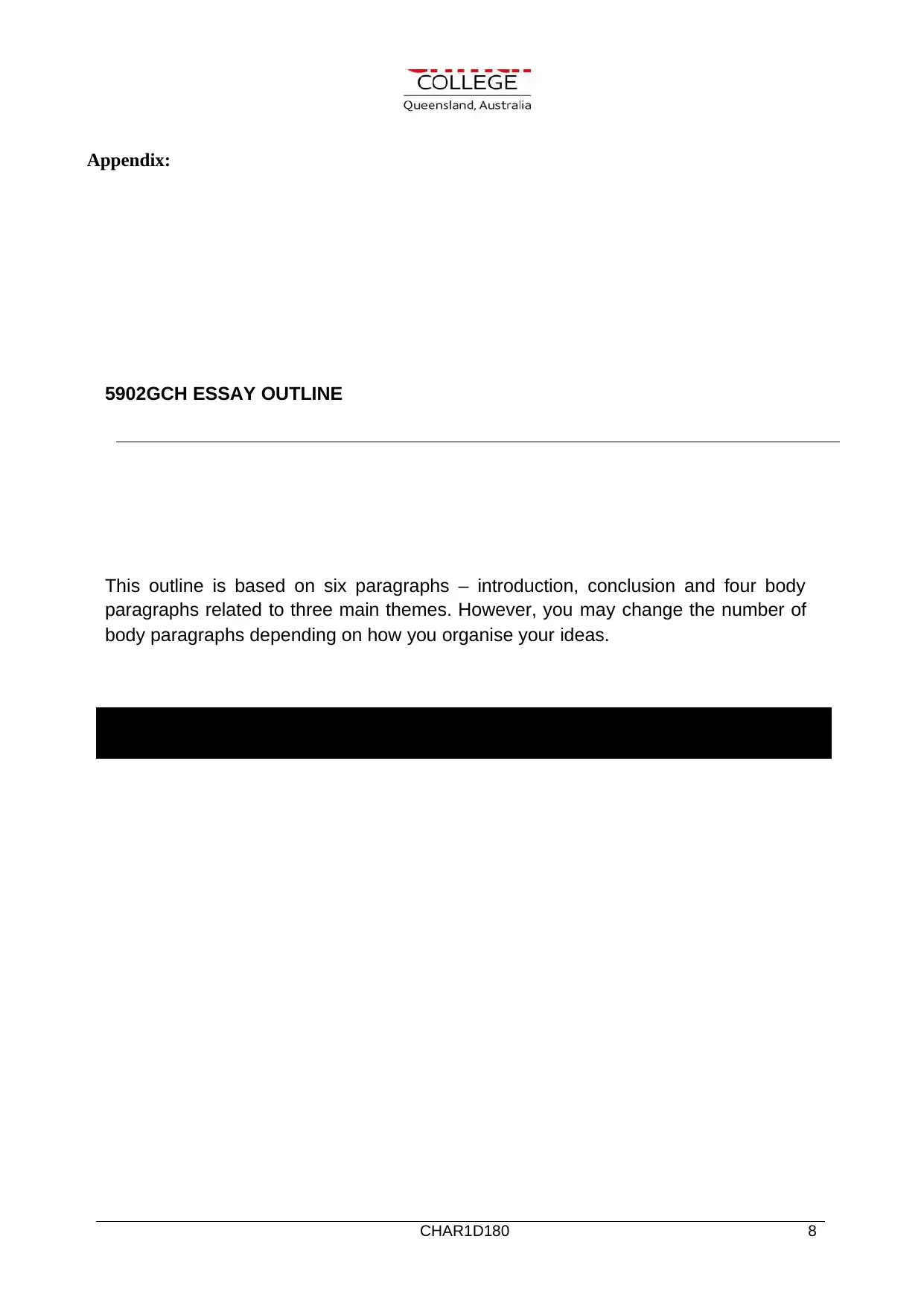
CHAR1D180
1
8
Appendix:
5902GCH ESSAY OUTLINE
This outline is based on six paragraphs – introduction, conclusion and four body
paragraphs related to three main themes. However, you may change the number of
body paragraphs depending on how you organise your ideas.
1. Introduction Source/s
1
8
Appendix:
5902GCH ESSAY OUTLINE
This outline is based on six paragraphs – introduction, conclusion and four body
paragraphs related to three main themes. However, you may change the number of
body paragraphs depending on how you organise your ideas.
1. Introduction Source/s
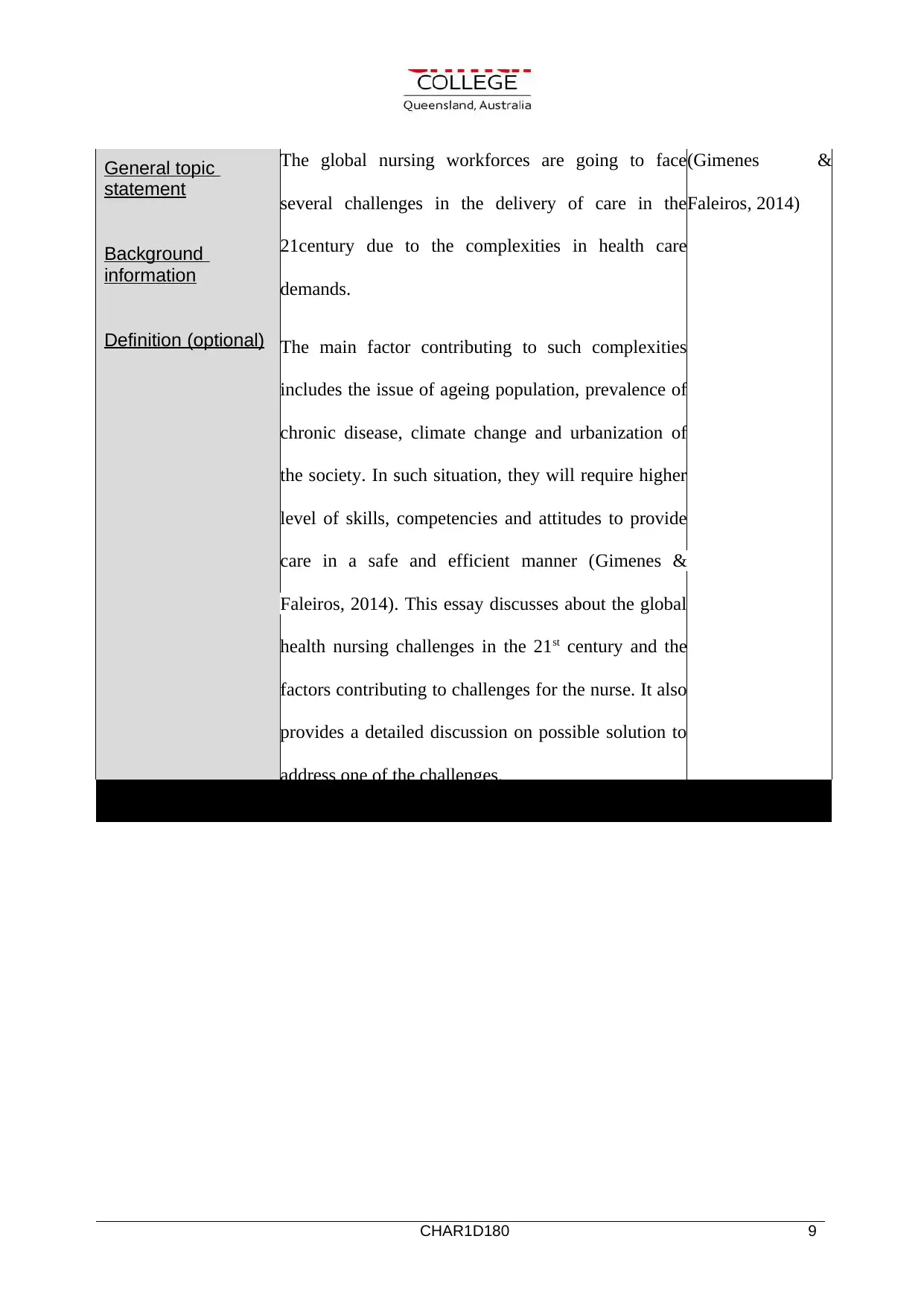
CHAR1D180
1
9
General topic
statement
Background
information
Definition (optional)
Thesis statement
The global nursing workforces are going to face
several challenges in the delivery of care in the
21century due to the complexities in health care
demands.
The main factor contributing to such complexities
includes the issue of ageing population, prevalence of
chronic disease, climate change and urbanization of
the society. In such situation, they will require higher
level of skills, competencies and attitudes to provide
care in a safe and efficient manner (Gimenes &
Faleiros, 2014). This essay discusses about the global
health nursing challenges in the 21st century and the
factors contributing to challenges for the nurse. It also
provides a detailed discussion on possible solution to
address one of the challenges.
(Gimenes &
Faleiros, 2014)
1st Body Paragraph Source/s
1
9
General topic
statement
Background
information
Definition (optional)
Thesis statement
The global nursing workforces are going to face
several challenges in the delivery of care in the
21century due to the complexities in health care
demands.
The main factor contributing to such complexities
includes the issue of ageing population, prevalence of
chronic disease, climate change and urbanization of
the society. In such situation, they will require higher
level of skills, competencies and attitudes to provide
care in a safe and efficient manner (Gimenes &
Faleiros, 2014). This essay discusses about the global
health nursing challenges in the 21st century and the
factors contributing to challenges for the nurse. It also
provides a detailed discussion on possible solution to
address one of the challenges.
(Gimenes &
Faleiros, 2014)
1st Body Paragraph Source/s
⊘ This is a preview!⊘
Do you want full access?
Subscribe today to unlock all pages.

Trusted by 1+ million students worldwide
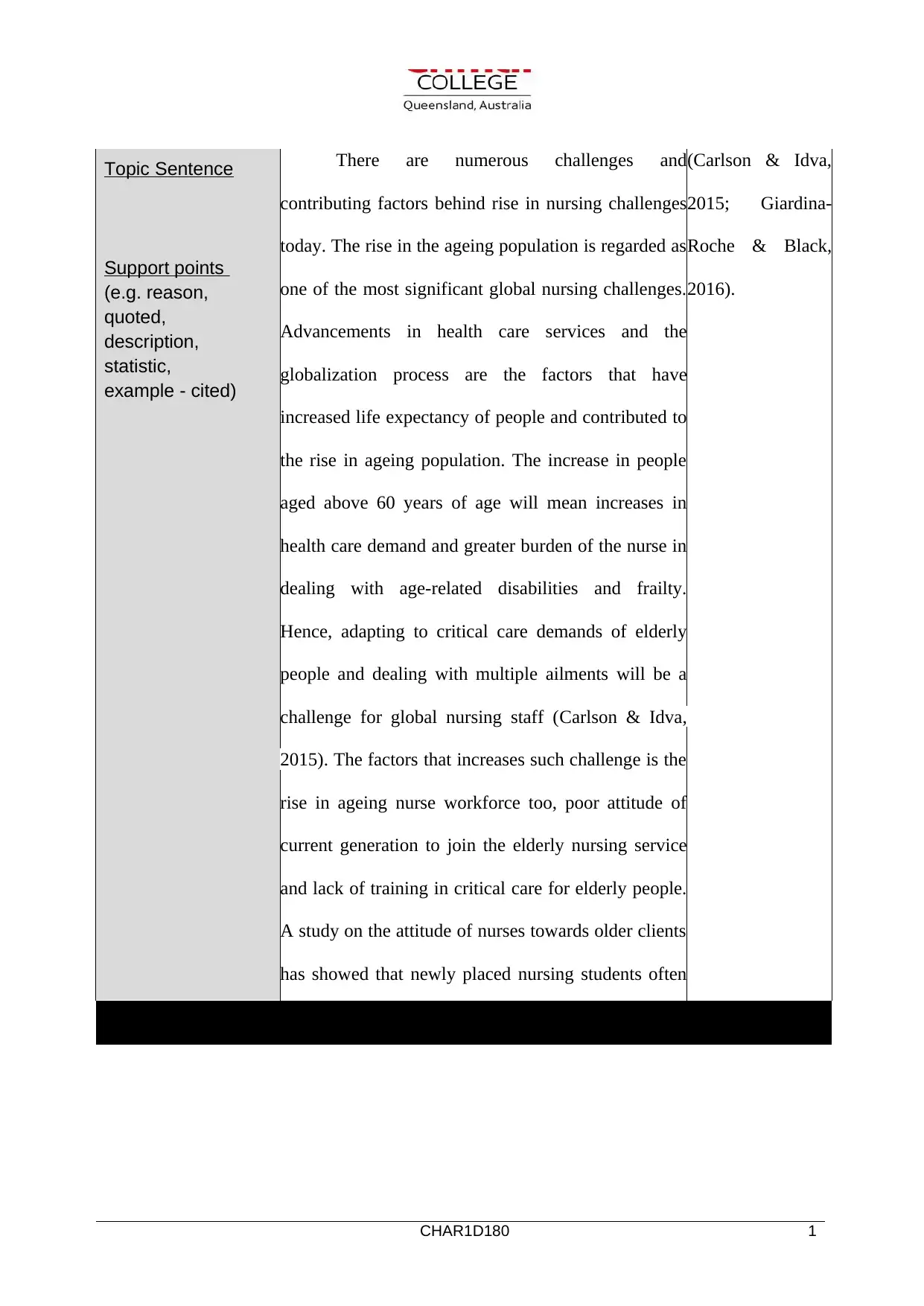
CHAR1D180
1
1
0
Topic Sentence
Support points
(e.g. reason,
quoted,
description,
statistic,
example - cited)
There are numerous challenges and
contributing factors behind rise in nursing challenges
today. The rise in the ageing population is regarded as
one of the most significant global nursing challenges.
Advancements in health care services and the
globalization process are the factors that have
increased life expectancy of people and contributed to
the rise in ageing population. The increase in people
aged above 60 years of age will mean increases in
health care demand and greater burden of the nurse in
dealing with age-related disabilities and frailty.
Hence, adapting to critical care demands of elderly
people and dealing with multiple ailments will be a
challenge for global nursing staff (Carlson & Idva,
2015). The factors that increases such challenge is the
rise in ageing nurse workforce too, poor attitude of
current generation to join the elderly nursing service
and lack of training in critical care for elderly people.
A study on the attitude of nurses towards older clients
has showed that newly placed nursing students often
have poor attitudes towards elderly people compared
(Carlson & Idva,
2015; Giardina-
Roche & Black,
2016).
2nd Body Paragraph Source/s
1
1
0
Topic Sentence
Support points
(e.g. reason,
quoted,
description,
statistic,
example - cited)
There are numerous challenges and
contributing factors behind rise in nursing challenges
today. The rise in the ageing population is regarded as
one of the most significant global nursing challenges.
Advancements in health care services and the
globalization process are the factors that have
increased life expectancy of people and contributed to
the rise in ageing population. The increase in people
aged above 60 years of age will mean increases in
health care demand and greater burden of the nurse in
dealing with age-related disabilities and frailty.
Hence, adapting to critical care demands of elderly
people and dealing with multiple ailments will be a
challenge for global nursing staff (Carlson & Idva,
2015). The factors that increases such challenge is the
rise in ageing nurse workforce too, poor attitude of
current generation to join the elderly nursing service
and lack of training in critical care for elderly people.
A study on the attitude of nurses towards older clients
has showed that newly placed nursing students often
have poor attitudes towards elderly people compared
(Carlson & Idva,
2015; Giardina-
Roche & Black,
2016).
2nd Body Paragraph Source/s
Paraphrase This Document
Need a fresh take? Get an instant paraphrase of this document with our AI Paraphraser
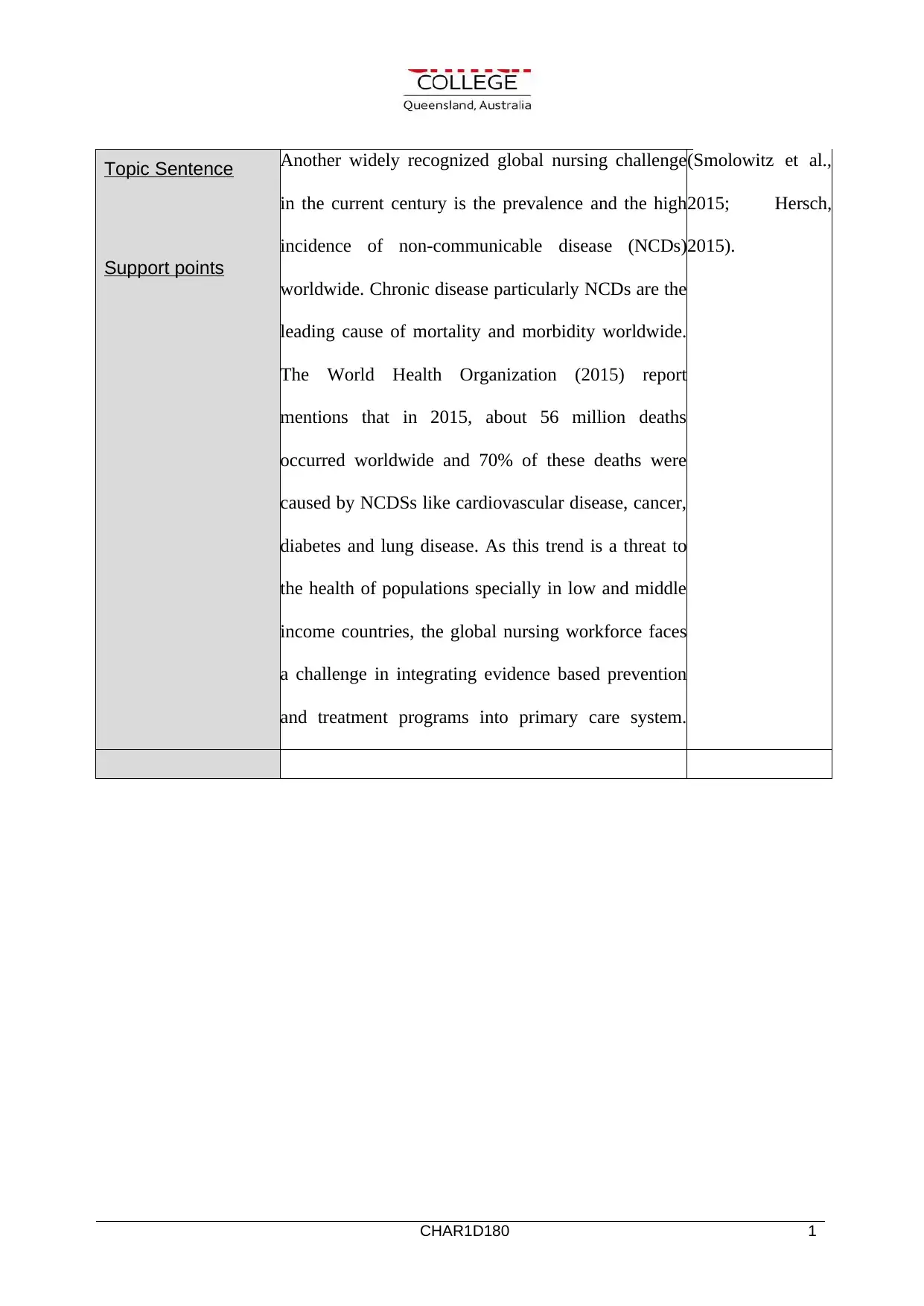
CHAR1D180
1
1
1
Topic Sentence
Support points
Another widely recognized global nursing challenge
in the current century is the prevalence and the high
incidence of non-communicable disease (NCDs)
worldwide. Chronic disease particularly NCDs are the
leading cause of mortality and morbidity worldwide.
The World Health Organization (2015) report
mentions that in 2015, about 56 million deaths
occurred worldwide and 70% of these deaths were
caused by NCDSs like cardiovascular disease, cancer,
diabetes and lung disease. As this trend is a threat to
the health of populations specially in low and middle
income countries, the global nursing workforce faces
a challenge in integrating evidence based prevention
and treatment programs into primary care system.
This challenge is further compounded by factors like
(Smolowitz et al.,
2015; Hersch,
2015).
1
1
1
Topic Sentence
Support points
Another widely recognized global nursing challenge
in the current century is the prevalence and the high
incidence of non-communicable disease (NCDs)
worldwide. Chronic disease particularly NCDs are the
leading cause of mortality and morbidity worldwide.
The World Health Organization (2015) report
mentions that in 2015, about 56 million deaths
occurred worldwide and 70% of these deaths were
caused by NCDSs like cardiovascular disease, cancer,
diabetes and lung disease. As this trend is a threat to
the health of populations specially in low and middle
income countries, the global nursing workforce faces
a challenge in integrating evidence based prevention
and treatment programs into primary care system.
This challenge is further compounded by factors like
(Smolowitz et al.,
2015; Hersch,
2015).
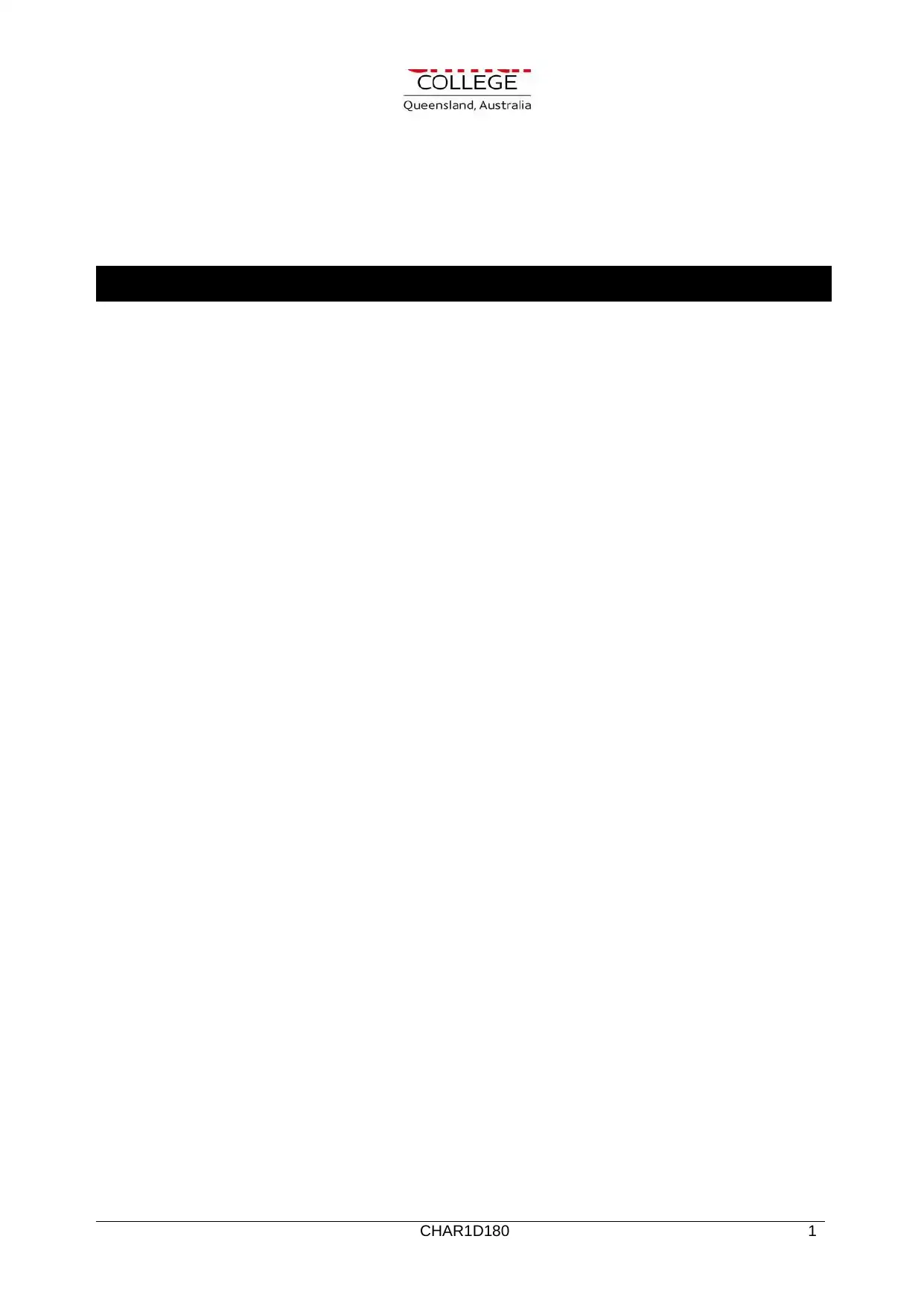
CHAR1D180
1
1
2
3rd Body Paragraph Source/s
1
1
2
3rd Body Paragraph Source/s
⊘ This is a preview!⊘
Do you want full access?
Subscribe today to unlock all pages.

Trusted by 1+ million students worldwide
1 out of 17
Related Documents
Your All-in-One AI-Powered Toolkit for Academic Success.
+13062052269
info@desklib.com
Available 24*7 on WhatsApp / Email
![[object Object]](/_next/static/media/star-bottom.7253800d.svg)
Unlock your academic potential
Copyright © 2020–2025 A2Z Services. All Rights Reserved. Developed and managed by ZUCOL.





